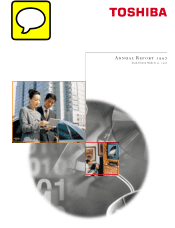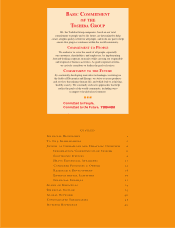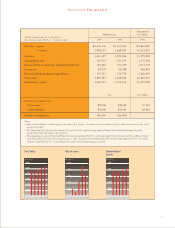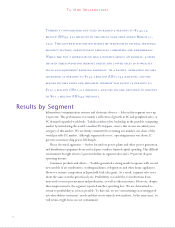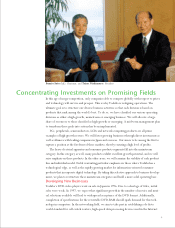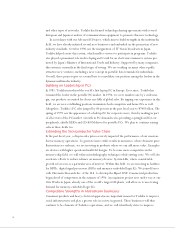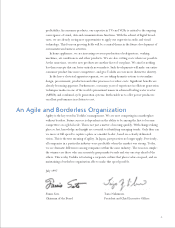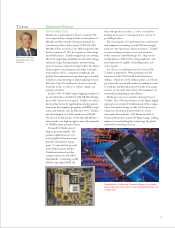Toshiba 1997 Annual Report Download - page 11
Download and view the complete annual report
Please find page 11 of the 1997 Toshiba annual report below. You can navigate through the pages in the report by either clicking on the pages listed below, or by using the keyword search tool below to find specific information within the annual report.
9.
Topics
Semiconductors
Markets for semiconductor devices in fiscal 1996
were impacted by a sharp decline in sales prices of
DRAMs and the extended slump in demand for
consumer products. Sales prices of 4M and 16M
DRAMs fell by as much as one-fifth compared with
the first quarter of 1996. In response to these huge
price fluctuations, Toshiba stepped up cost cutting
efforts by upgrading capabilities in ultra-fine design
rule processing. Raising capacity and operating
speed of memory chips also helped offset the effects
of the negative environment somewhat. Demand
from makers of PCs, computer peripherals and
mobile telecommunications products grew steadily.
Toshiba is concentrating on digital signal processors
and other logic ICs and bipolar devices to benefit
from this trend, as well as to reduce reliance on
memory products.
In June 1996, Toshiba began shipping samples of
an extended-data-out (EDO) 64M DRAM offering
the world’s fastest access speed. Toshiba was able to
develop this device by applying knowledge gained
from joint development programs with IBM Corpo-
ration and Siemens AG. In February 1997, Toshiba
unveiled samples of a 64M synchronous DRAM.
The first of its kind in the world, this DRAM has a
data transfer rate high enough to meet the demands
of 100MHz main memory busses.
this card operates on only 3.3 volts, essential for
holding down power consumption in a variety of
portable products.
The convergence of communications, audiovisual
and computers is making system LSIs increasingly
critical to the operation of many products. Toshiba
is concentrating resources on several attractive
fields: memory-embedded logic ICs; chip sets for
mobile phones; LSIs for PCs and peripherals; and
media processors capable of handling audio and
video signals.
In a move to a unifying vision for system LSIs,
Toshiba in September 1996 participated in the
formation of the VSI (Virtual Socket Interface)
Alliance. Members of the alliance plan to accelerate
growth in the system LSI market by making it easier
to combine intellectual property blocks from many
sources on one chip. More than 100 companies are
currently participating in this alliance.
Media processors are another strategic focus at
Toshiba. The 1996 introduction of the Mpact digital
signal processor placed Toshiba ahead of the compe-
tition. Demand is rising steadily for this processor,
which was developed jointly with U.S.-based
Chromatic Research Inc. SGS Thomson and LG
Semiconductor have joined the Mpact camp, adding
impetus toward making this technology the global
standard for media processors.
Developed by Toshiba and Chromatic Research, the Mpact
digital signal processor places seven multimedia functions on
a single chip.
Electronic Devices
Masanobu Ohyama
Senior Executive Vice
President
Demand for flash memory
chips is growing rapidly. The
primary applications are cur-
rently digital still cameras and
portable information equip-
ment. To spur further growth
in the flash memory market,
Toshiba introduced an ultra-
compact memory card called
SmartMedia. Containing a 64M
NAND-type flash EEPROM,

